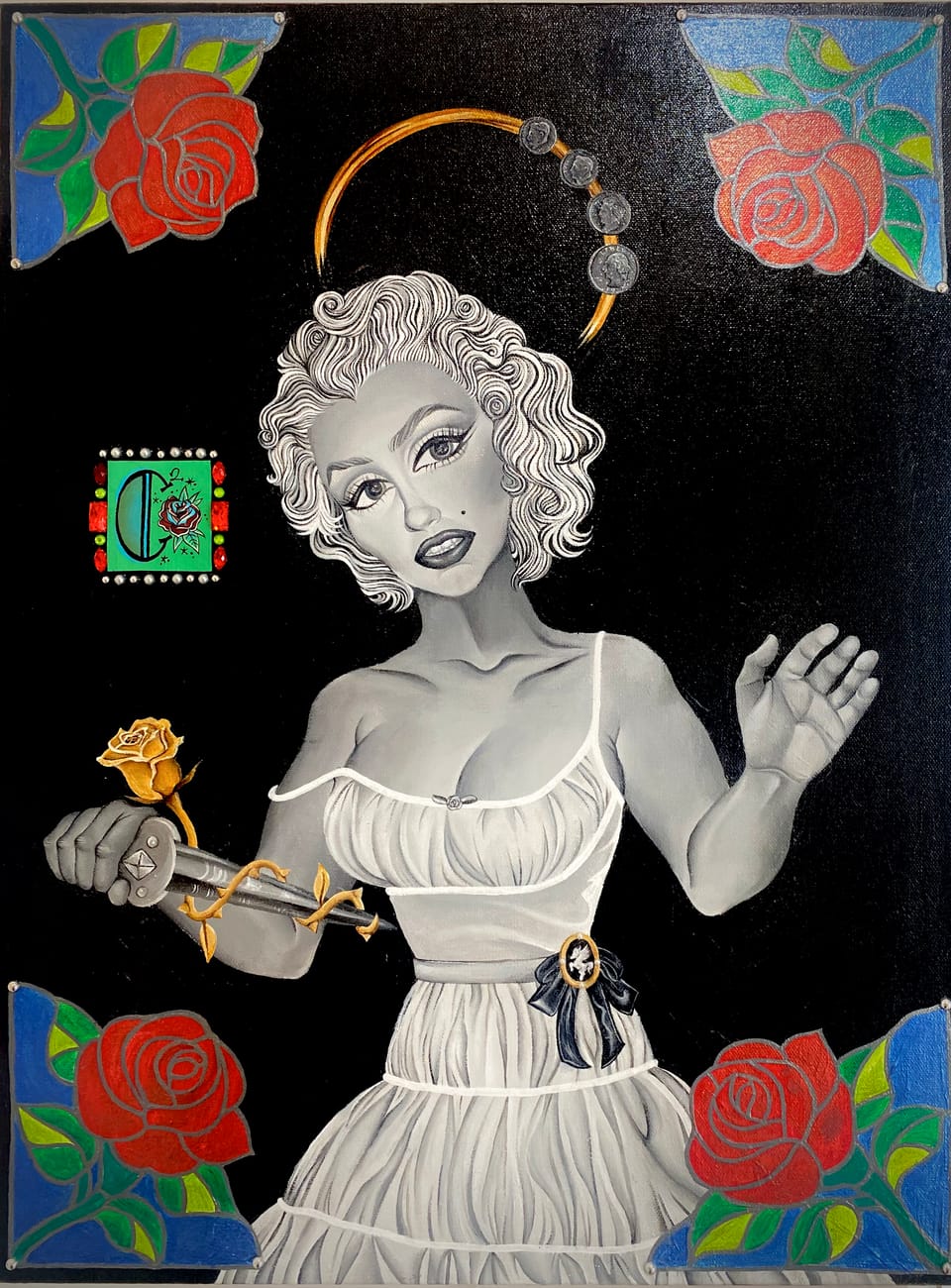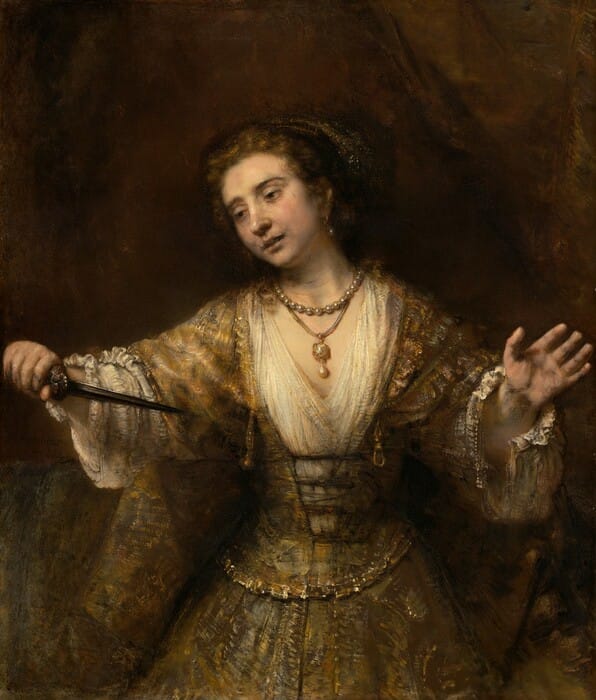F.C. Arts: Willard’s ‘The Worth of a Woman’ Wins People’s Choice Award in All-Members M-Z Show

The people have spoken – and selected a bold and provocative work.
Falls Church Arts (FCA) announced July 26 that the “winner of the People’s Choice Award for the All-Members Show (M-Z)” exhibition is Claire Willard’s “acrylic with embellishments” painting, “The Worth of a Woman: Marilyn as Lucretia.”
The annual, all media exhibition is open at Falls Church Arts’s gallery at 700-B West Broad St. now through Aug. 10.

Intriguingly, the winning artist, Claire Willard, has no evident biographical information on FCA’s website, in the gallery itself, nor online. Her People’s Choice-winning entry is on sale through FCA for $10,000.
“For thousands of years, Lucretia stood as artists’ representation of futile efforts of faultless womanhood,” Willard’s blurb for the painting reads. “In the age of mass-media, Marilyn has taken that place. This painting is an exploration of unwavering exploitation of women through time. The composition is based on Rembrandt’s Lucretia which hangs in the National Gallery.”
Willard’s 30 x 40-inch winning painting depicts an iconic black-and-white film-style figure of Marilyn Monroe as a seemingly exploited, buxom “sex symbol,” putting a dagger to her chest, in an allusion to Dutch painter Rembrandt van Rijn’s 1664 oil painting “Lucretia.”
The National Gallery of Art (NGA) describes Rembrandt’s “Lucretia,” as follows: “Shown from the thighs up, a pale-skinned woman [Lucretia] looks down and off to our left as she holds the pointed end of a dagger toward her chest in this vertical painting. Her lips are slightly parted, and her arms are spread wide as she holds the hilt of the dagger in her right hand, to our left. Her hooded, dark brown eyes are rimmed with red. Her head tilts to our left, her pale lips parted…. She is warmly lit from the upper left and set against an earth-brown background. The artist signed and dated the center left, “Rembrandt 1664.”

Willard’s piece places the black-and-white figure of Marilyn with the dagger against a starkly black background, contrasted by four lushly blooming bright red roses, one in each corner, perhaps signally an affirmation of her life, worth, and potential immortality. Her dagger, however, has a foreboding message: a sepia-toned, thorny rose is slithering upward like the temptation of Eve’s snake from its tree in Eden.
To fully interpret Willard’s work, however, one needs to enquire about the historical figures in the painting’s name: Marilyn Monroe and Lucretia.
Most viewers are aware that Marilyn Monroe lived a life of stark contrasts, deftly conveyed in Willard's painting. On the one hand, after an impoverished childhood, Monroe rose in Hollywood to become perhaps the greatest starlet and “sex symbol” in American film history. On the other, however, she struggled with depression, as she was typecast as a “dumb blonde,” despite her intelligence, acting skills, and ability to manage her own acting contracts and productions in the patriarchal entertainment environment of the 1950s and 60s.
Similar to the historical figure Lucretia, Marilyn’s honor “as a woman” was also questioned after her nude photos were published. At the age of 32, Monroe is believed to have taken her own life, by overdose, in 1962.
So, who was Lucretia?
“The tragic story of Lucretia, recounted by Livy, took place in Rome in the sixth century BC during the reign of the tyrannical ruler Tarquinius Superbus,” the NGA posted on its website. Rembrandt portrays Lucretia in utter anguish, right before her act of suicide. The tension surrounding that awful moment poignantly captures the moral dilemma of a woman forced to choose between life and honor.”
“Lucretia's husband, Collatinus, had boasted to his fellow soldiers that her loyalty and virtue were greater than that of their wives,” the post continues. “Taking him up on the challenge, the men immediately rode to Rome where they discovered Lucretia and her handmaidens spinning wool. Lucretia's very virtue inflamed the desire of Sextus Tarquinius, son of the tyrant, who secretly returned to the house a few days later. Lucretia received him as an honored guest, but he later betrayed that hospitality by entering her chamber and threatening to kill her if she did not yield to him. The next day Lucretia summoned her father and husband, disclosed what had happened, and told them that, even though they deemed her an innocent victim, she was determined to end her life in order to reclaim her honor. Lucretia then drew a knife from her robe, drove it into her heart, and died. Overwhelmed by grief and anger, Lucretia’s father, her husband, and two accompanying friends swore to avenge her death. Lucretia's rape and death triggered a revolt that led to the overthrow of monarchical tyranny and the creation of the Roman Republic.”
By ingeniously connecting Monroe and Lucretia to emphasize the historical de-valuation and exploitation of women – with high concepts of “a woman’s honor” used to manipulate women to further disadvantage – the painter Claire Willard has succeeded in teaching vital lessons in art history.
We could all use such insightful depth and boldness in our art.
The All-Members (M-Z) Show runs through Aug. 10.
The Falls Church Arts gallery is open from Tuesday-Friday, 11 a.m. to 6:00 p.m. and Saturday-Sunday, 9:00 a.m. to 4:00 p.m. Artworks can be viewed online at www.fallschurcharts.org. All pieces can be purchased at the gallery or on the website.
By Christopher Jones






Member discussion